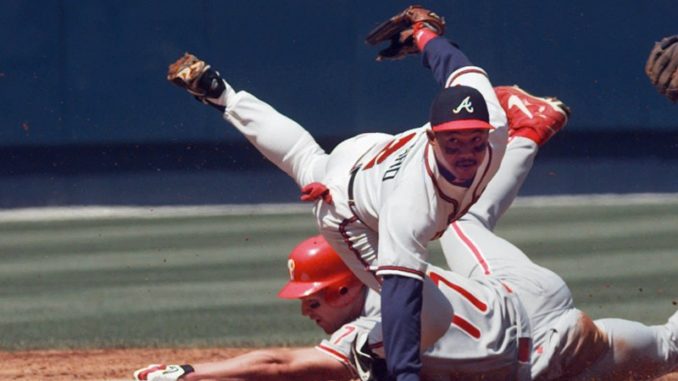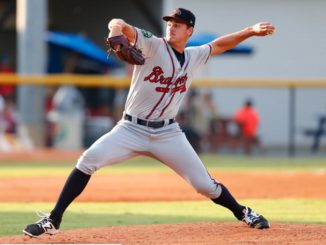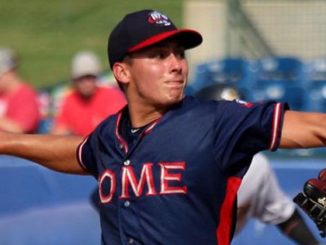The Atlanta Braves have:
-
Signed SS Adeiny Hechavarría to a one-year major league contract
-
Recalled RHP Bryse Wilson from AAA Gwinnett
-
Optioned OF Adam Duvall and IF Johan Camargo to AAA Gwinnett
-
Designated RHP Wes Parsons for assignment

The Braves made a move to address the less-than-impressive defensive play the team has gotten from the shortstop position since Dansby Swanson was forced to the injured list with a heal contusion by signing free agent shortstop Adeiny Hechavarría. But this post isn’t going to be about him very much. Suffice to say that he has a good defensive reputation (his 20 Defensive Runs Saved over the last 8 years ranks 15th in the major leagues among all shortstops in that time frame) and a poor offensive one (lifetime .252/.288/.346 slash line, and even worse than that in a part-time role with the New York Mets before they released him earlier this week).
In short, he’s an overall replacement-level major leaguer. However, his strengths as a player are just what the Braves have been missing at shortstop lately.
Chicks Dig the Groundball (Pitchers)
Through 123 games in 2019, Braves pitching has induced opposing batters to a 44.7% groundball rate, good for 5th-best in the major leagues. This is not a coincidence. In an era where a combination of playing with a juiced ball and good hitters more than willing to take advantage of it to shatter home run records, having a pitching staff that can limit that damage by keeping the ball on the ground is a smart way to get outs. Eight pitchers on the Braves current pitching staff own groundball rates better than the league average, and that includes all three of the relievers added to the Braves at the trade deadline, Mark Melancon, Shane Greene, and Chris Martin.
Groundballs have often been called “a pitcher’s best friend” because of how often they are converted to outs at the major league level. While major league hitters have a .302/.299/.389 slash line this season when putting the ball in play overall, those numbers drop to .239/.239/.263 on ground balls. They are also the most reliable way of killing a rally by inducing a double play.
This probably isn’t news to most of the readers here, but I want to emphasize this point because of how much the Atlanta Braves have emphasized it, and with good reason. The 2018 Atlanta Braves had arguably the best infield defense in the game with all four regular starters in the top 10 in MLB in Defensive Runs Saved and Ultimate Zone Rating, with first baseman Freddy Freeman securing his first Gold Glove Award. The Braves acquisitions for the pitcher’s mound the last two trade deadlines were made to exploit that team strength. In addition to the three relievers added at the 2019 trade deadline, the three pitchers added for the 2018 deadline — Kevin Gausman, Brad Brach, and Jonny Venters — also had higher than average groundball tendencies, as well as this season’s big free agency move, Dallas Keuchel, who had the largest groundball rate of any qualified pitcher in 2018.
In short, the Braves over the last two seasons have made a big bet that their infield defense will elevate their pitching staff, and their pitching acquisitions have been their markers. And almost every baseball fan understands that the shortstop is the lynchpin infield defensive position. Thus having a strong defensive shortstop can have an exponentially good effect on the team’s chance of winning when a groundball pitcher is on the mound, as has often been the case this year for Atlanta.
But the reverse is also true: a poor defensive shortstop will have an exponentially bad effect on the team’s chance of winning.

The Belliard Effect
The problem then becomes, what happens when that lynchpin breaks? One week before the 2018 playoffs began, Swanson’s injured wrist, which negatively impacted his offense all season, suffered a setback on a swing that pushed him to the disabled list and out of the playoff picture. Swanson’s replacement at shortstop, the able and clutch-hitting Charlie Culberson, was nevertheless not quite up to Swanson’s standards at the keystone. While it would be both untrue and unfair to say that Culberson playing shortstop instead of Swanson against the Dodgers in the NLDS cost the Braves a shot a advancing, there is no doubt in the minds of anyone watching carefully that several ground balls that just eluded Culberson looked like plays that Swanson had made before.
This has proven to be the case again with Swanson’s latest absence. This time the Braves had a choice of fill-ins in both Culberson and Johan Camargo. Camargo has gotten most of the opportunity, and has utterly failed to run with it. At the plate, Camargo has only hit .185/.264/.292 since July 18 in regular playing time. There are a lot of theories why Camargo isn’t performing up to expectation, from his disappointment at being supplanted at third base by Josh Donaldson, to the failure of manager Brian Snitker to utilize him as a super-utility player, to him not participating in winter ball last off-season. The latter of those excuses has been used repeatedly lately by Braves GM Alex Anthopoulos, and reading between the lines can give the impression that the organization was not impressed with Camargo’s off-season conditioning.
Whatever the reason, in addition to slumping at the plate, Camargo has also been slumping in the field. Once considered one of the top shortstops in the Braves organization as he was coming up the minor league ranks, Camargo lost a step of range after building up his body to become more of an offensive threat. He was more than rangy enough however for third base, and in 2018 was one of the top defensive third baseman in the majors. As he’s played shortstop regularly over the last four weeks however, Camargo has shown to be increasingly timid in the field, has shown poor footwork around the bag, and his strong arm has seemed somewhat scattershot on throws to first base.
The Braves have also tried Culberson at shortstop, and as in 2018 the more playing time the Braves top pinch hitter has gotten, the more exposed he has gotten both at the plate and in the field. Although his overall offensive line for 2019 is still strong, Culberson has only hit .235/.257/.294 in August, a time that coincided with Snitker giving Culberson more of an opportunity as a shortstop. Again Culberson has also demonstrated poor range at short.
This is where I remind anyone still reading how critical shortstop defense is for the pitching to work. This is why Hechavarría is at least temporarily the starting shortstop for the Atlanta Braves, despite his meager offensive skills.
Long time fans will remember Rafael Belliard, who in the 1990s got a surprising amount of playing time over the more offensively-skilled Jeff Blauser despite being a nearly pitcher-level offensive player. Belliard’s defense at short exponentially helped the likelihood of groundball pitchers like Tom Glavine, Steve Avery, Mike Bielecki, and Charlie Leibrandt. This is the same principle.
The Shortstop Crisis
That this move needed to be made reflects poorly on Atlanta’s depth at the shortstop position. While Camargo’s offensive struggles are likely a surprising disappointment to the team, that he had lost a step at shortstop was obvious. Likewise the team got an up-close view of Culberson-as-shortstop in the playoffs last season.
It’s not like the Braves have no shortstops at AAA Gwinnett however. The Braves added minor league free agents Pedro Florimon and Jack Lopez to incumbent minor league veterans Scott Kazmar and Luis Marte. While each of them are fine for minor league depth however, there’s reason to believe than none would provide the shortstop play that the team’s pitching staff requires. Florimon was once a plus defender at shortstop, but seems to have bulked up this off-season to become a bigger offensive threat and simultaneously lost a step at shortstop; he has mostly split time between third and first base. Marte is the best of this group in the field, but he has never played in the major leagues and is hitting a Hechavarría-esque .254/.289/.344 this season.
The options at Mississippi are more intriguing with the toolsy Ray-Patrick Didder and Riley Unroe and the just-promoted from Rome Braden Shewmake, a 2019 draft pick. None have sniffed the majors, though Unroe did spend time at Gwinnett. If Swanson’s injury persists, or Camargo’s poor play continues in Gwinnett, I suspect the Braves will look closely at this group in a “break glass in case of emergency” way in September. To say the the Braves didn’t anticipate being in this situation is an understatement.
The Other Parts of the Move
- With right-hander Josh Tomlin throwing 5 innings in Thursday’s 10-8 loss to the Mets, the Braves needed a multi-inning pitcher for the bullpen, and Friday was Wilson’s planned start date for Gwinnett so he got the call.
- Duvall’s move to Gwinnett is likely temporary as the team will not want to continue with a short bench for long. This was a case of Duvall having options and fellow outfielder Rafael Ortega not having options.
- To make room on the 40-man roster for Hechavarría, the Braves elected to designate right-hander Wes Parsons for assignment. It seems likely that another team will put in a claim for him given his success at the AAA level and relative success in 17 games for Atlanta this season. Parsons was a non-drafted minor league free agent who signed in 2013 and battled through TJS and a slew of top-flight pitching prospects added to the system during the rebuild to make it to the majors last season.




Leave a Reply